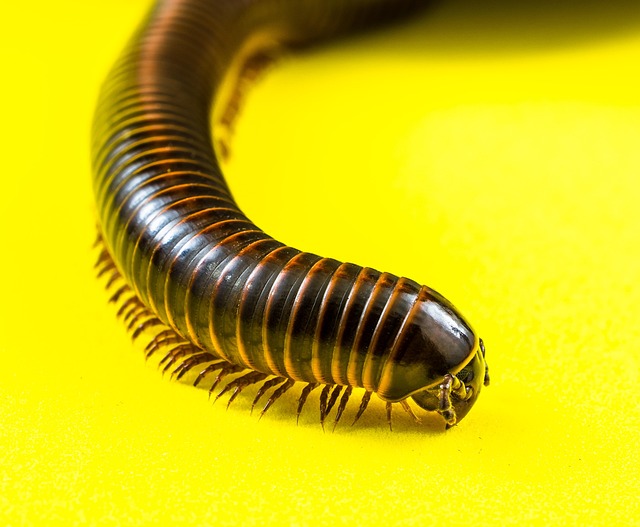Millipede infestations require a strategic approach due to their quick proliferation and hidden behavior. Professional services specialize in identifying entry points, using both chemical (sprays, baits) and non-chemical treatments (heat, vacuum) for effective control. DIY methods offer temporary relief but don't address root causes. Modern professional removal combines eco-friendly strategies like biological controls with precise chemical applications, ensuring long-lasting pest elimination. Preventative measures include regular inspections, sealing gaps, and maintaining hygiene to minimize future risks, backed by expert recommendations for optimal results.
Millipedes are a common household pest, often causing unease with their large numbers and peculiar appearance. Understanding their behavior and life cycle is key to effective millipede infestations control. This article explores comprehensive solutions to eliminate these creatures, from traditional DIY methods to modern chemical and non-chemical treatments. We also delve into long-term strategies for preventing future infestations, highlighting the importance of professional millipede removal for severe cases.
Understanding Millipede Infestations: Common Causes and Entry Points
Millipede infestations can quickly become a nuisance, but understanding their behavior is key to effective control. These creatures are attracted to dark, moist environments and often enter homes through cracks, gaps, or unscreened doors and windows. They may also be introduced via outdoor potted plants or organic materials like wood or compost. Identifying common entry points is crucial for professional millipede removal. Homeowners should inspect their properties for any signs of damage or gaps that might allow these pests to enter, especially in areas with high moisture levels such as basements, kitchens, and bathrooms.
Professional millipede removal services employ specialized treatments tailored to each unique infestation scenario. Experts use a combination of chemical and non-chemical methods to ensure thorough and long-lasting results. Chemical solutions include targeted sprays and baits that disrupt the millipedes’ life cycle, while non-chemical options like heat treatments or vacuum systems offer effective alternatives for specific cases. By addressing the root causes and employing these advanced strategies, professional services provide efficient solutions, restoring peace of mind and a pest-free living environment.
Traditional Methods for Millipede Control: DIY vs Professional Approaches
Many homeowners initially turn to traditional methods for millipede control, often attempting DIY solutions before considering professional help. The most common approach involves using household pesticides and insecticides, which can be effective in containing smaller infestations. These products are readily available and offer an immediate line of defense against these creatures. However, while they may provide short-term relief, they don’t always address the root cause of the infestation.
When millipede populations grow or infest areas beyond the reach of DIY treatments, it’s time to consider professional millipede removal services. These experts employ specialized equipment and a deeper understanding of millipede behavior to ensure thorough and long-lasting control. Professional pest controllers can identify entry points, pinpoint breeding grounds, and implement targeted strategies, including biological control methods, to eliminate millipedes from homes and properties effectively.
Modern, Effective Treatments: Chemical and Non-Chemical Solutions
In the modern era, professional millipede removal offers a range of effective treatments that cater to both chemical and non-chemical solutions. Chemical treatments involve the application of specialized insecticides designed to target millipedes specifically. These chemicals are carefully chosen for their safety to humans and pets while maintaining high potency against the pests. Professional applicators ensure precise placement of these treatments in hard-to-reach areas, cracks, and crevices where millipedes tend to hide, providing a fast and efficient eradication.
Non-chemical solutions focus on environmental modifications and cultural practices to deter and control millipede populations. This includes proper sanitation, sealing entry points, and reducing moisture levels. Experts may also recommend the introduction of natural predators like certain spiders or insects that feed on millipedes. These non-toxic methods are ideal for homeowners seeking eco-friendly options. Combining these modern treatments allows for comprehensive and long-lasting professional millipede removal, ensuring a pest-free environment.
Preventing Future Infestations: Long-Term Strategies and Best Practices
Preventing future millipede infestations is a crucial aspect of long-term home protection. The first line of defense involves regular inspections, especially in areas prone to moisture accumulation and dark, secluded spaces where millipedes tend to hide. Sealing entry points like cracks, gaps around pipes, and doors can help keep them out. Maintaining excellent hygiene, including regularly cleaning and disinfecting, reduces the risk of attracting these pests.
Professional millipede removal experts recommend using a combination of methods for optimal results. This may include applying residual insecticides in strategic locations, setting up sticky traps, or employing baiting systems designed to target millipedes specifically. By combining these strategies and staying vigilant, homeowners can effectively manage existing infestations and implement robust long-term prevention plans.
Millipede infestations can be effectively managed through a combination of understanding their behavior, employing modern treatments, and implementing preventive strategies. For severe or persistent cases, professional millipede removal services offer specialized knowledge and tools to eliminate these pests safely and thoroughly. By combining traditional methods with modern, non-chemical solutions, homeowners can reclaim their spaces from these unwelcome invaders. Preventive measures like sealing entry points and maintaining outdoor cleanliness significantly reduce the risk of future infestations, ensuring a more comfortable and pest-free living environment.
